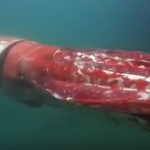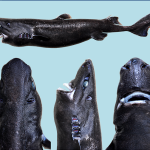
This is a guest post from Sizing Ocean Giants team member Leo Gaskins
1) Not the best cook? No worries, Greenland sharks won’t complain!
Forgot to thaw your frozen turkey? Have too many leftovers to fit in your fridge? Not so confident in your cooking skills? No worries. Your new Greenland shark friend won’t judge you!
Greenland sharks are some of the least picky eaters you’ll ever run into. They have been documented with many strange things in their stomachs, ranging from polar bears, horses, even a whole reindeer! In fact, this month, in Newfoundland, some people saved a Greenland shark that was choking on a moose.
Though these odd things have been discovered in their stomachs, their diet usually consists of fish. They are also known as the Sleeper shark, and have a lethargic cruising speed of .76 mph to match their nickname. As they lazily move around the ocean, they aren’t usually catching too many quickly moving organisms. But lucky for you, in addition to fish, they also eat carrion, which are dead and decaying animals. So that Thanksgiving turkey you just cooked fits right into their typical menu. No need to cook them anything out of the ordinary!
2) Fearful of your heating bill this winter? Your shark friend doesn’t mind the cold!
Greenland sharks, as the name suggests, do in fact live near Greenland, in the sub-arctic latitudes, and are the only true sub-arctic shark, found in temperatures around 33 degrees Fahrenheit! In other words, even if they stayed outside the whole night, they would still be perfectly fine!
Greenland sharks are also surprisingly large, and can get up to around 20 feet, the same size as a Great White Shark. But contrary to what you might think, when animals get larger, they actually have to put in less energy to maintain a constant internal temperature. This phenomenon, called gigantothermy, boils down to some basic physics. Larger animals have a larger volume to surface area ratio than smaller animals. This means that relative to the rest of their body mass, there is less skin exposed to the water where heat can escape.
3) Looking for some compelling dinner conversation? Greenland sharks have plenty to tell!
Each Thanksgiving, along with the food and family, come the stories. My grandfather always has the most interesting ones, telling us about his childhood, his time in WWII as a medic, and what life was like in previous decades. At 88 years old, he has a wealth of knowledge and experience that makes each Thanksgiving story and family discussion interesting.
So why invite a Greenland shark? What would they have to bring to the table? Though not widely studied, Greenland sharks are believed to be the vertebrate with the longest lifespan, at over 200 years!
To give you perspective on how long 200 years really is, the United States as a nation is only 237 years old, the civil war was 150 years ago, and my family has gone through about eight generations since then. I can only imagine that these sharks would have incredibly compelling stories to tell, and be able to offer a unique voice in family discussions. In addition, even shark researchers know very little about the lives of the elusive Greenland sharks, so it would be interesting to understand more about what they do as they slowly cruise through the Arctic seas.
Share the post "3 Reasons Why You Should Invite a Greenland Shark to Thanksgiving Dinner"







4) Fancy a bottle of wine but can’t open the bottle? No worries. Ask any grey seal about Greenland sharks and corkscrews and you’ll have your answer.
That was a really cool post. I’m going to write a post about Orcas and having them pretend to come over for Thanksgiving is funny. 200 years is a long time, what makes them live for so long?
I am a few years behind on my “are sharks warm blooded” trivia, but last I heard, thermoregulation was only something observed in the faster sharks in need of the extra power that warmer tissue provides. Now you’re saying the Greenland shark uses this as well?
Wow! i didnt know they were blind! this website has helped me and my classmates with countless projects! thanks! KEEP UP THE POSTS!